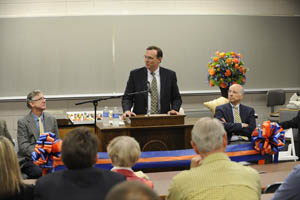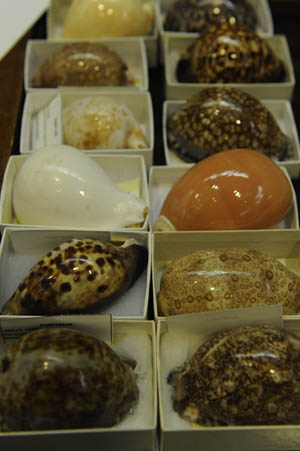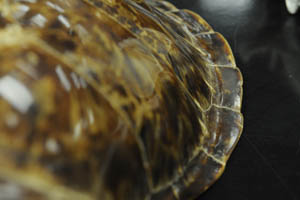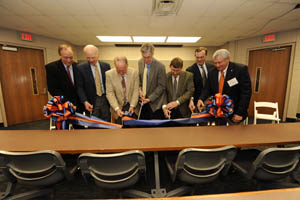COSAM opens Biodiversity Learning Center
On Friday, April 19, the College of Sciences and Mathematics hosted a ribbon cutting ceremony commemorating the opening of the new Biodiversity Learning Center. Construction of the Biodiversity Learning Center was made possible by a $3.5 million bond, and the 15,000 square-foot facility is located between Funchess Hall and Rouse Life Sciences Building on campus.
The Biodiversity Learning Center is the new home of Auburn University's Museum of Natural History. The museum includes hundreds of thousands of specimens representing the rich history of Alabama, the Southeast and beyond. For more than 25 years the museum collection was located in Funchess Hall and the Physiology Building on campus, and Auburn has maintained natural history collections for more than 50 years. The Biodiversity Learning Center represents years of dedication and planning by supporters of COSAM, including faculty, staff, administration and alumni.
"Biodiversity, simply stated, is the variety of life on earth. It is our greatest resource. The air we breathe the water we drink, the food, the shelter, and the drugs that keep us healthy, are all a part of the living world," said Jack Feminella, chair of the Department of Biological Sciences and curator of Aquatic Invertebrates for the Museum of Natural History. "The Biodiversity Learning Center, which houses the Auburn University Museum of Natural History, is ideally positioned to showcase the important role of Auburn in preserving its natural heritage and the significant role of COSAM faculty and students in helping avert the loss of diversity through research, education and outreach."
The museum is used primarily by Auburn professors and students conducting biodiversity research. Museum curators will also periodically extend the vast collection beyond campus and provide specimens to outside researchers as well as to K-12 outreach programs.
"Research, education and outreach are the major components of the museum, and the new infrastructure will help us to meet our goals," said Jason Bond, director of the Museum of Natural History. "There is an on-going loss of biodiversity. Natural history collections serve as a record of what is here, what we are losing and how the ranges of species are changing through time. We should be very concerned about biodiversity loss, and museum collections help to highlight why it's important. Biodiversity is integral to human health, quality of life and ultimately our survival as a species. As a museum we are very committed to the concept that natural history collections play a significant and important role in biodiversity research, conservation and education, a role that is integral to the land grant mission of Auburn University."
Included in the museum is the John D. Freeman Herbarium, a large collection of insects, and more than 450,000 preserved fish specimens.
"In addition to incredibly extensive collections of Alabama plants, insects and fishes, we have a spectacular collection of southeastern frogs, snakes and lizards," said Bond. "Some of our most important specimens are those that are characterized as 'types.' Types are specimens that will forever be associated with species that our curators were the first to describe. Our collection includes type specimens for several new fish species and notably, Myrmekiaphila tigris, also known as the 'Auburn Tiger Trapdoor Spider.'"
The specimens contained in the museum are maintained by nine museum curators and four collections managers. They are: Jonathan Armbruster, curator of fishes; Troy Best, curator of mammals; Jason Bond, curator of arachnids and myriapods; Stephen Dobson, curator at large; Jack Feminella, curator of aquatic invertebrates; Les Goertzen, curator of plants; Craig Guyer, curator of amphibians and reptiles; Geoffrey Hill, curator of birds; Charles Ray, curator of insects; Curtis Hansen, collections manager for plants; Brian Helms, collections manager for invertebrates; David Laurencio, collections manager for tetrapods; and David Werneke, collections manager for fishes.
To learn more about the Museum of Natural History, visit the website at www.aumnh.org.
Latest Headlines
-
04/18/2024
-
04/18/2024
-
04/18/2024
-
04/17/2024
-
04/12/2024




